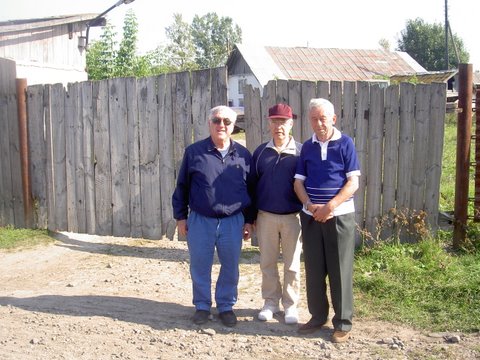Alternate names: Glinyany and Глиняны [Rus], Gliniany [Pol], Glina and גלינע [Yid], Hlyniany and Глиняни [Ukr], Glinah, Gline, Hlynjany. 49°49' N, 24°31' E, 50 miles WNW of Ternopil (Tarnopol), 23 miles E of L'viv (Lvov), 10 miles N of Peremyshlyany. An organized Jewish community existed from 1474 with the first settlers as leaseholders. The Jews of Glinyany suffered Tatar raids and Cossack massacres in 1624, 1638, and 1657, particularly in 1648-49. The first synagogue, wooden, was erected in 1704.n the 18th century, Glinyany became a center of Ḥasidism when R. Jehiel Michael Moskovich established his court there. A Jewish-German school in Glinyany, established under Joseph II after Austrian annexation of Galicia, remained open until 1806. A Baron Hirsch public school existed from 1816 to 1914. Jewish population: 688 in 1765, 1,708 in 1880 ( total 3,695), 2,177 in 1900 (total 4,906), 1,679 in 1921 (total 4,355), 1,906 in 1931, and 2,300 in 1939.
- Megiles Gline (Glinyane): zikroynes un iberlebungen fun a khorev gevorener kehile
(New York, 1950) - Khurbn Glinyane (Gline): lezikorn unzere ḳdoyshim
(New York, 1946) - Kehilat Glina 1473-1943; toldoteha ve-hurbana
(Jerusalem, 1950) - Pinkas ha-kehilot; entsiklopediya shel ha-yishuvim le-min hivasdam ve-ad le-aher shoat milhemet ha-olam ha-sheniya: Poland vol. 2: Eastern Galicia
(Jerusalem, 1980)
- Encyclopedia of Jewish Life (2001), p. 434: "Gliniany".
- Pinkas HaKehilot, Poland, Vol. 2 (1980), p. 140-145: "Gliniany"
- Shtetl Finder (1989), p. 24: "Glina, Gliniany".
- Słownik Geograficzny Królestwa Polskiego (1880-1902), II, pp. 583-585: "Gliniany".
- Jewish Records Indexing Poland Town Page
- Virtual Shtetl Museum of the History of Polish Jews
- Galicia SIG
GLINYANY: US Commission No. UA13360101
Alternative names: German: Gliniany Polish: Gliniany. It is located in Lvovskaya Oblast at 49º49' and 24º31', 41km from Lvov. The cemetery is located at the east part of the village at Zhetnitskiy St. tractor station. Present town population is 1000-5000 with no Jews.
- Town officials: town chief Mikolaichuk Vasil Petrovich [Glinyany, Shevchenko St., 38, tel.: 51645] Town soviet.
- Regional officials: Lvov Regional State Administration, Lvov, Vinnichenko St., 18, reception room, tel.: 722947, 728093. Lvov Center State Historical Archives (CSHA), Lvov, Sobornaya Square, 3a, tel.: 723508.
- Lvov Jewish Community, Lvov, Mikhnovskih St., 4, tel.: 330524, Rabbi Mordekhai Shloime Bold.
The earliest mention of Jewish Community is 1474. 1900 Jewish population was 2177. Events effecting Jewish community were 1758 francists [sic] settlement in Glinuany, 1894 fire, opening of Jewish school of b. Girsh, and "the first nation house in Galitsiay this Hebrew courses" [sic]. The unlandmarked cemetery dates from the 17th century with last known Orthodox Jewish burial in 1941.The cemetery is within the tractor station. The isolated suburban plain has no sign or marker. Reached by crossing public tractor station, access is open with permission. Continuous fence and a gate with lock surround site. The approximate size of the cemetery before the World War II was 0.3 hectares but now is hard to determine. There are no gravestones. Some of the tombstones are part of roads or structures. The municipality owns the site used only as Jewish cemetery. A residential area borders cemetery. The cemetery boundaries are smaller than in 1939 because of the commercial and industrial building. The cemetery was vandalized during World War II and since. Within the cemetery are manufacturing structures of tractor station. No threats because no stones.
Gelston Iosif, Lvov, 290049, PO Box 10569, tel./fax: (0322) 227490 completed survey on 30.10.98. Documentation: CSHA, Fond 186, inventory 6, page 11; Jewish Encyclopedia, B.6, page 586, St Petersburg, 1910; Akta grodzkie i ziemskie, T.15, nr.1324, Lwow (in Polish). Iosif Gelston visited the site for this survey in 15.10.98 and interviewed town chief Mikolaichuk Vasil Petrovich, Glinayny, Shevchenko St., 38, tel.: 51645.
Photos taken in Sept. 2006 were contributed by This email address is being protected from spambots. You need JavaScript enabled to view it., Portage, MI [August 2009] - The men are in front of the"gate from the street into Glinyany cemetery" and the other photo is of the "Sawmill replace the Soviet era tractor station operating at site of cemetery.
Additional photos from the cemetery before its destruction can be found at "The photographs in the book," at the end of the Table of Contents. [May 2011]


